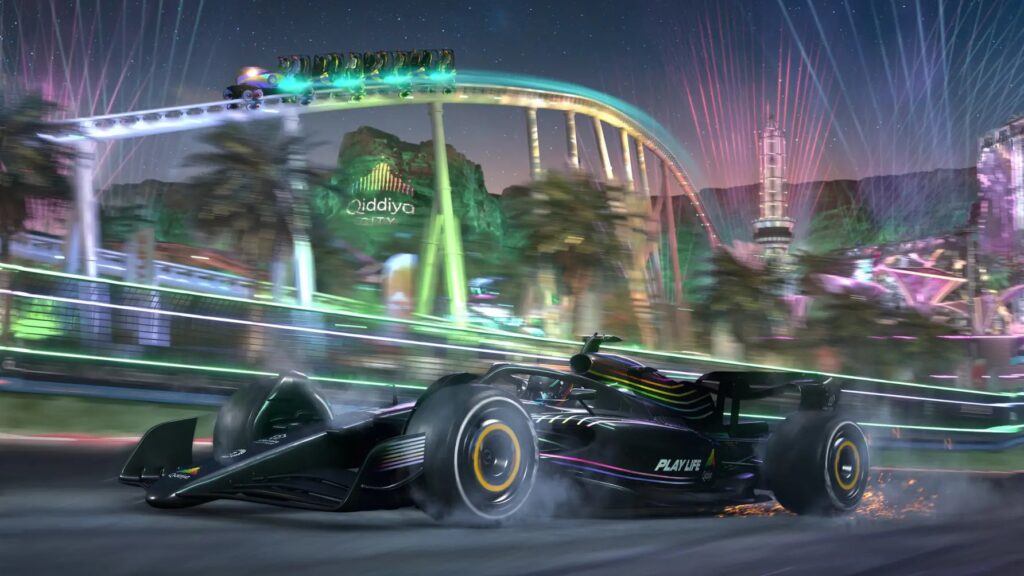
It’s been an exciting time for those operating at the intersection of brand marketing and consumer culture, with several notable moments in the gaming and immersive entertainment space.
Firstly, the Cannes Lions finally recognized the importance of games in consumer culture with a dedicated category award – the Entertainment Lion for Gaming. The introduction of this award attracted a mix of high-quality entries from agencies all around the world for endemic and non-endemic brands – many engaging with the category for the first time.

On the surface, this was simply a long-overdue validation of the medium. However, no one predicted that it would be the gaming Grand Prix winner – W+K’s brilliantly observed ‘fake’ campaign for Clash of the Clans 40th Anniversary – that would go on to beat work in all the other adjacent subcategories of Music, Sport, and Branded Content to win the overall Entertainment Grand Prix.
It was literally a game-changer moment, if you can excuse the pun.
Then, just as the well-earned high-fives in Cannes subsided, Nike dropped its first playable experience inside Fortnite with the launch of Airphoria, a visually stunning immersive playable experience. Airphoria was built using the newly released Unreal Editor for Fortnite (UEFN). This tool allows brands and creators to construct their unique Fortnite experiences and release them directly to the players. In Airphoria, players and their friends are transported to a visually immersive universe centered around Air Max sneakers. They can engage in virtual sneaker hunts and various team-based mini-games for a fun and exciting experience.

The integration into both Fortnite and Nike’s virtual ecosystems was well thought through, allowing players to purchase a range of virtual Nike apparel in the Fortnite shop for use in-game, as well as rewarding play with redeemables in .swoosh – Nike’s blockchain-based web3 virtual community fandom platform that features exclusive digital-only merch.
And, of course (and no less important to the overall Airphoria strategy) was the release of a limited Airphoria-inspired collection of physical products on the Nike website in North America.
This Epic/Fortnite deal may also hint at what their previously-announced partnership with EA Sports will reveal later this year. It promises to create “new immersive experiences” and to “unlock brand-new levels of customization within the EA SPORTS ecosystem” by allowing Nike .swoosh members and players “unique new opportunities for self-expression and creativity through sport and style.”
This multiple-strand approach to gaming collaborations and campaigns from Nike (we’ll touch on their partnership with Roblox a little later) perfectly finds the sweet spots in gaming and sneaker culture. Nike and its partners collectively contribute and enhance existing ecosystems whilst delivering new types of value to each. If the Airphoria experience is anything to go by, we expect it and future gaming campaigns to perform exceptionally well in the newly-annointed Cannes Lions Gaming category next year.
Finally and most recently, amongst all the hullabaloo of launching their Twitter rival Threads, Meta announced that Roblox was coming to Quest VR later this summer. This is quite possibly the biggest announcement to happen to Quest since it launched.
What makes this news so significant is the sheer size of the existing Roblox audience – some 66m+ Daily Active Users (DAUs) – and what that could mean to the fledgling Quest platform. Even if only 1% of those Roblox players choose to sample the VR version, that would represent much-needed triple-digit growth for Quest.
On the surface, this appears to be a very one-sided deal in Meta’s favor. Still, I suspect Roblox may be eyeing Meta’s underlying (and mature) ad tech stack to support the rollout of more brand integration possibilities and allow creators to monetize their playable experiences on the platform. It’s often forgotten that Roblox was the OG immersive 3D sandbox platform, launching five years before Minecraft. For a long time, it was the only option to create and publish playable 3D experiences to an active player base. Now, Fortnite is attempting to challenge this position with its new creative mode and the introduction of tooling and pipelines like UEFN.
Each of these three announcements alone are significant moments, but taken collectively, they prove that immersive and playable experiences are entering the mainstream and becoming important components of a consumer brand’s engagement strategy.
How did we get here?
Back in 2019, Netflix turned heads on its Q4 earnings call when it declared that it considered Fortnite more of a competitor than HBO or any of the other premium streaming services operating at the time. This came at a time when many considered them to be the poster child of double-digit year-on-year growth, and the blueprint for a whole new digital entertainment industry.
Many scoffed at this claim, but the numbers bore witness. In basic “share of screen time” measurements, it was clear that many, MANY millions were choosing to spend (increasing) amounts of time enjoying Fortnite with their friends and peers.
The word “enjoying” holds significance here (instead of “playing”) because although Fortnite did attract millions of DAUs at that time, the overall engagement extended far beyond just playing the game. The community surrounding Fortnite included those who watched YouTubers play it competitively and those in Discord and Twitch communities discussing game tactics. This total engagement surpassed the numbers seen by traditional linear video services by a considerable margin.
The Fortnite numbers surged even further during the pandemic when some of the exclusive in-game live concert appearances from Marshmello and Travis Scott gave us a glimpse of the modern hybrid concert experience, with one-off viewerships akin to some live sporting TV broadcasts. During the same time, Roblox was actively addressing the challenges posed by COVID-19. It organized regular awareness and fund-raising events via themed mini-games to unite and entertain the millions of people temporarily confined to their homes due to lockdowns the world over.
Fast forward to mid-2023, and while the boost gaming received in the pandemic has subsided, it has returned to its previous growth trajectory. Audiences are 4+ years older now, and many younger players have now crossed into adulthood. Hence gaming is definitely a mainstream media for those who’ve grown up with these virtual playable 3D experiences as the norm.
The release of UEFN and Epic’s push into the creator and marketing space, plus the parallel developments in Roblox’s own Studio platform for creators, all point to a new era ahead for brands publishing playable immersive experiences as part of their marketing mix. It’s clearly time for marketers to move gaming from the “experimental” to the “core” line in their budgets.
How easy is it for brands to create immersive playable experiences?

Having platforms ready to welcome your brand and host your playable experiences is one thing, but creating the right experience for your game-playing audience is a much bigger challenge – and where many brands can get it wrong.
Aside from basic demographic profiling and audience matching to choose the platform with the most overlap with your target audience, you need to propose playable experiences that make sense on that platform, leverage its strengths and allow your brand to make a positive contribution to that community of players. Proposing the wrong activity, or forcing a platform to try and do things it was never designed to do, could be game over.
The maturity and scale of Roblox creates tremendous possibilities, as the platform’s flexibility means that many gameplay types are possible, and moving from one game experience to another can result in wildly different experiences. Action-packed shooters, tycoon games, simulations, puzzles, and role-playing games are all possible (and popular) on the platform.
Fortnite, on the other hand – as a new entrant – is more focused on the types of gameplay it currently offers creators. It mirrors closely the core activities familiar on Fortnite Island’s Battle Royales that currently attract those millions of DAUs. This results in playable experiences that major on exploring, scavenging, surviving, and (if your brand safety rules allow it) face-to-face armed combat.
Both platforms offer easy integration and accurate representation of your existing 3D assets – objects, environments, or even characters – albeit with the necessary optimizations for real-time rendering. Each platform overlays its own subtle aesthetic ‘treatment’ which appeals to its core player base – skewing younger for Roblox and older for Fortnite – but that visually anchors your experience within their world. It’s interesting to compare and contrast Nike’s recent Airphoria experience in Fortnite with its earlier Nikeland experiences in Roblox, and notice how very different they appear to be on the surface, but how similar in fidelity and detail the featured core sneakers are – the aspect Nike (and any brand) cares the most about.
Regardless of platform, the potential for genuine immersivity sets these 3D gaming platforms apart from other opportunities in the gaming space and should be what brand marketers grab onto and embrace the most.
Players can be entirely surrounded by (expansive) visual environments and soundscapes, totally immersed in a narrative in which they can participate and, to some extent, direct, and interact with other players collaboratively or in bouts of friendly rivalry. The average session time for these endeavors is frequently over 10 mins, and average playtimes over a week are often measured in hours for the most engaging experiences.
Compared to other options for brands to engage directly with consumers for such periods of time, those numbers are highly desirable, and why so many brands are considering playable 3D experiences.
Case Study: Walmart Land
A great example is our recent work creating Walmart Land on Roblox.
Walmart has already enjoyed a very positive relationship with young adults, with nearly 80% of this group having a favorable opinion of the brand. Still, that relationship was very functional and transactional, and as the cost of living began to increase, it was imperative to nurture these customers of the future in new ways.
Walmart set out to transform its brand from a basic supplier of things to a supplier of experiences – and to do it in a way that connected with its audience authentically. Roblox was the natural choice – a place that offered limitless immersive experiences and where these young adults were the fastest-growing group.
In Walmart Land, players can explore Electric Island, enjoy mini-games and challenges, and watch and participate in the island’s very-own summer festival. There’s also an exclusive digital “verch” store to find the perfect avatar outfit for YUNGBLD’s headliner at “Electric Fest.”
And besides being a ton of fun to experience, it worked HARD for Walmart.
The program didn’t just maintain the positive perception of Walmart held by young adults, it increased love for the brand with all those who interacted with the experience. Brand affinity was up 10 points (1% over benchmark), purchase intent surged +17% (4% over benchmark), and the propensity of WOM recommendation jumped +21% (10% over benchmark).
Over the course of this program, the experience has seen over 18.5 million total users. During the most active parts of the campaign, Walmartland had over 102k DAUs. It proves that a brand like Walmart can drive engagement and momentum in a platform like Roblox, where one wouldn’t normally see a big box retailer succeed.
Tips and tricks for branding success
How can you ensure your brand will be welcomed and embraced, and not left out of a player’s load-out?
- Gaming IS culture.

You wouldn’t describe film enthusiasts as ‘movie-rs’ or radio listeners as ‘music-ers’, so don’t define game-playing audiences by the basic underlying media and simply call them ‘gamers’.
Instead, recognize that gaming is a positive entertainment choice many millions make every day, and as such, is an important part of their lives and their identity.
There is plenty of audience overlap for endemic and non-endemic brands to exploit if you take the time to understand how gaming fits into your existing audiences’ lives. They take play seriously, and so should you.
- Embrace the diversity, respect the anonymity.
There is a wealth of diversity within those millions of DAUs. Those who believe that gaming is a majority male activity might be surprised to learn that a recent industry report found 47% of console gamers in the US are women, with about 52% of Nintendo Switches being female-owned, making it the most popular console for the demographic. Female players also make up 50% of PC video game players and 54 percent of mobile game players. And with an average age of 35, statistics like these render the common perception of teenage boys in bedrooms utterly redundant.
Furthermore, gaming has long been recognized as a relatively safe and inclusive space for the LGBTQ+ community to unite. Gaming platforms have fully embraced individuality and self-expression through avatars, skins, and emotes, and often find great success in monetizing these features too. This acceptance and creative expression surpass that of social media and other online communities.
By the same measure, it’s entirely possible to live parallel lives inside game worlds, and deliberately keep your identity IRL separate from your online identity in-game. This wreaks havoc with data-driven marketing that seeks to track behavior across platforms, but gamers highly covet the anonymity option, and it is something worth accepting.
- Co-create and credit.
The community is a big part of the appeal of gaming, and community members are used to being heard. It’s not enough to simply deploy a game – however good it may be – and expect them to simply play it. Instead, invest time into developing a deep understanding of the community, its values, and what it wants. Brands who put gamers first in this way, and invite them into the creative process so they can feel their fingerprints on a game, will succeed.
- Be in it for the long haul.
Like any other fandoms, such as sports and music, gamers love watching games as much as they like playing them. And often, they like talking about games even more than they like watching other people playing those games.
You should not overlook the around-game opportunities, as these are an important component of success. Gamers are very savvy and recognize brands that ‘dump and run’ without taking the time to engage, involve, and converse with the community. Fortunately, there are a plethora of options for how to do this in native ways through platforms like Twitch, whether directly or via a growing influencer community.
In the evolving landscape of brand marketing and consumer culture, the convergence of gaming and immersive entertainment has emerged as a pivotal force. As gaming continues to mature and captivate a diverse audience, brands must skillfully navigate this realm, embracing authenticity, co-creation, and community engagement to forge meaningful connections and elevate their marketing strategies to new heights. The question now is, are you ready to take your brand marketing to another level?





